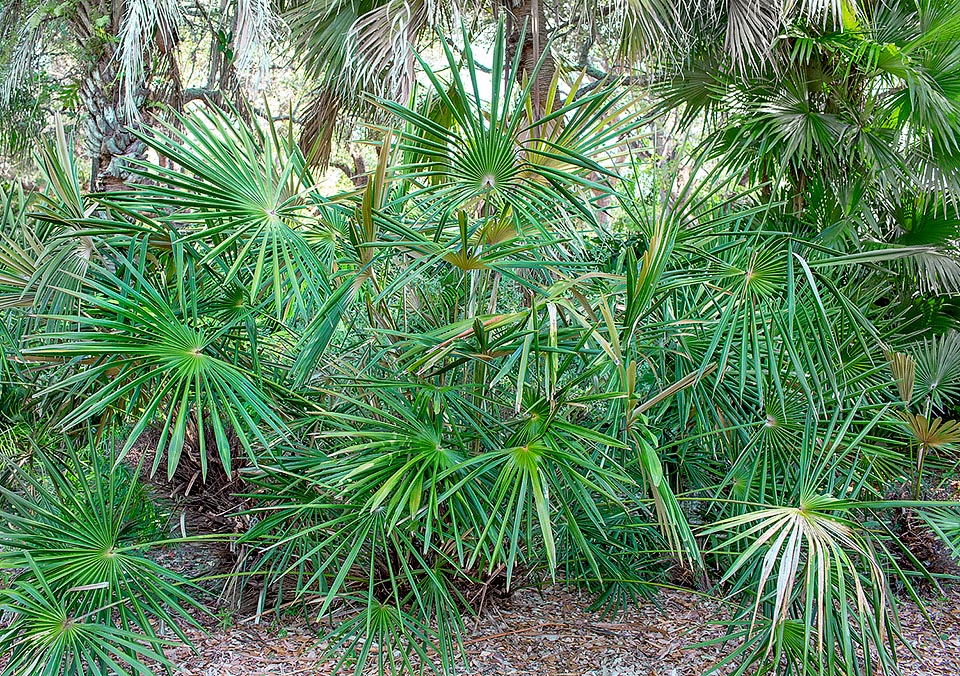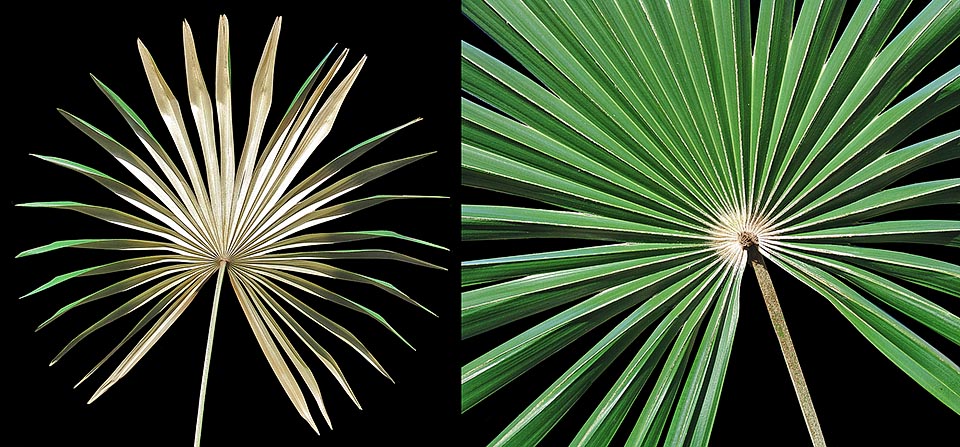Family : Arecaceae

Text © Pietro Puccio

English translation by Mario Beltramini

The Guihaia argyrata is a dioecious, caespitose species, native to China and Vietnam, with short erect or recumbent stem of 3-5 cm of diameter that rarely reach the 50 cm © Giuseppe Mazza
The species is native to China (Guangdong, Guangxi and Guizhou) and north-eastern Vietnam where it lives in the open forests on the steep slopes and in the crevices of the karst limestone heights at medium altitudes.
The name of the genus is the old one of the Guilin region in the Guangxi, that of the species is the Latin adjective “argyratus, a, um” = silvery, coming from the Greek “αργυροῦς” (argyrus), with reference to the colour of the lower page of the leaf.
Common names: dainty lady palm, Guilin dwarf palm, silver back fan palm (English); shi shan zong (Chinese).
The Guihaia argyrata (S.K.Lee & F.N.Wei) S.K.Lee, F.N.Wei & J.Dransf. (1985) is a dioecious, caespitose species, with erect or recumbent short stems, of 3-5 cm of diameter, that rarely reach a length of 0,5 m. Leaves, on an unarmed petiole 0,9-1,15 m long and 1 cm broad, palmate, reduplicate (with the section of the segments shaped like an inverted V), almost circular, of 0,8-0,9 m of diameter, divided in 20-30 linear-lanceolate segments with just bifid apex, about 4,5 cm broad, united at the base for less than 1/3 of their length, of glossy dark green colour above, densely covered below by a grey-silver down, at times with pale bronze reflections. The foliar base degrades in numerous rigid fibres, erect, acicular, up to about 15 cm of length and 1 mm of breadth, of dark brown colour.

The palmate leaves with the section of the segments shaped like an up down V, are almost circular, 80-90 cm broad, divided in 20-30 linear-lanceolate segments with just bifid apex. They are glossy dark green over and thickly covered on the lower page by a short hairiness grey-silvery, at times with bronze reflections © Pietro Puccio
Similar male and female inflorescences between the leaves (interfoliar), erect, 40-80 cm long, very ramified with ramifications of fourth order, rachis and rachillae of pale brown colour and tiny flowers, of about 1,5 mm of diameter, of green colour, spirally arranged. Globose fruits, of about 0,6 cm of diameter, of bluish colour containing only one globose seed of about 0,4 cm of diameter.
It usually reproduces by seed in draining loam, alkaline, maintained humid at the temperature of 26-28 °C with germination times of 3-4 months or even more.
Of particularly slow growth, possible cause of its limited diffusion, caespitose, but usually with a central stem predominating long time on the other just hinted ones, is an ideal ornament, due to its contained dimensions, of small gardens, where it distinguishes for the clear contrast between the dark green of the upper page of the leaf and the silvery grey of the lower one. It adapts to an ample variety of climates, from the tropical to the temperate one, where it has proved resistant up to temperatures around the -8 °C, of soils, provided draining, with preference to the alkaline ones, even if it resists the full sun, for a more intense colouration is preferable a position from slightly shady to shaded. Though coming from zones characterized by subtropical humid climate without a marked dry season, it has proved suitable also to the Mediterranean type climates, bearing short periods of drought without showing particular sufferings, it is however better to give it good humidity with regular waterings.
Synonyms: Trachycarpus argyratus S.K.Lee & F.N.Wei (1982).
